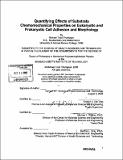| dc.contributor.advisor | Krystyn J. Van Vliet. | en_US |
| dc.contributor.author | Thompson, Michael Todd | en_US |
| dc.contributor.other | Harvard University--MIT Division of Health Sciences and Technology. | en_US |
| dc.date.accessioned | 2009-06-30T16:37:32Z | |
| dc.date.available | 2009-06-30T16:37:32Z | |
| dc.date.copyright | 2008 | en_US |
| dc.date.issued | 2008 | en_US |
| dc.identifier.uri | http://hdl.handle.net/1721.1/45915 | |
| dc.description | Thesis (Ph. D.)--Harvard-MIT Division of Health Sciences and Technology, 2008. | en_US |
| dc.description | Includes bibliographical references (p. 193-201). | en_US |
| dc.description.abstract | It is now widely accepted that cells are capable of processing both mechanical and chemical signals from the extracellular environment. Exactly how these two factors affect the cell biology in the context of physiological circumstances is an area of intense interest that has given rise to an entire field of study called cell mechanotransduction. The unambiguous decoupling of mechanical and chemical properties that stimulate cell development and phenotypic change is challenging from an experimental standpoint. This thesis describes some of the first studies of chemomechanical coupling arising from anchorage-dependent forces between cells and a versatile class of chemically and mechanically tunable polymer thin films, termed polyelectrolyte multilayers. Specifically, investigation of the effects of extracellular chemomechanical stimulation on cell morphology and adhesion in the eukaryotic cells such as vascular endothelial cells and fibroblasts; and the adhesion of prokaryotic cells S. epidermidis and E. coli are presented. Endothelial cells (EC) comprise a major portion of the cell population in the human body. Because of the extensive distribution of endothelial cells in various tissues, they function across a broad range of mechanical and chemical environments. Furthermore, a general understanding of how mechanical forces contribute to the development of cellular function is an important aspect in the development of therapeutic techniques and materials capable of addressing a wide spectrum of human diseases and injuries. Cell adhesion to extracellular matrices and tissues can be indicative of underlying molecular processes in both healthy and disease states. | en_US |
| dc.description.abstract | (cont.) Through the use of a mechanically tunable class of polymer thin films called polyelectrolyte multilayers (PEMs) developed by Rubner et al., we have demonstrated that the adhesion and morphology of human microvascular endothelial cells depend directly on the mechanical stiffness of these synthetic substrates, as quantified by the nominal elastic modulus E. Characterization of the mechanical properties and surface features of PEMs is attained via scanning probe microscopy (SPM) and SPM-enabled nanoindentation. Typical cellular response to increased substrata stiffness includes increased number of cells adhered per unit substratum area. We have further demonstrated that the chemical and mechanical signals imposed at the cell-substrata interface can be decoupled, thereby providing two independent parameters capable of controlling cell behavior. This capacity of the cell to sense and/or exert chemical and mechanical forces, in addition to initiating a sustained molecular response, is termed the chemomechanical response element. Finally, adhesion dependent mechanosensation in bacteria is explored, with respect to the chemomechanical response elements common to eukaryotic and prokaryotic cells. Potential applications towards the development of therapeutic materials and compounds for treatment of various disease states are discussed, with particular attention to limiting hospital acquired infections. | en_US |
| dc.description.statementofresponsibility | by Michael Todd Thompson. | en_US |
| dc.format.extent | 201 p. | en_US |
| dc.language.iso | eng | en_US |
| dc.publisher | Massachusetts Institute of Technology | en_US |
| dc.rights | M.I.T. theses are protected by
copyright. They may be viewed from this source for any purpose, but
reproduction or distribution in any format is prohibited without written
permission. See provided URL for inquiries about permission. | en_US |
| dc.rights.uri | http://dspace.mit.edu/handle/1721.1/7582 | en_US |
| dc.subject | Harvard University--MIT Division of Health Sciences and Technology. | en_US |
| dc.title | Quantifying effects of substrata chemomechanical properties on eukaryotic and prokaryotic cell adhesion and morphology | en_US |
| dc.type | Thesis | en_US |
| dc.description.degree | Ph.D. | en_US |
| dc.contributor.department | Harvard University--MIT Division of Health Sciences and Technology | |
| dc.identifier.oclc | 320772582 | en_US |
